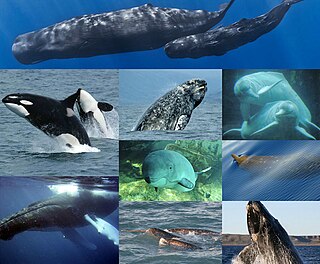Related Research Articles

Cetacea is an infraorder of aquatic mammals belonging to the order Artiodactyla that includes whales, dolphins, and porpoises. Key characteristics are their fully aquatic lifestyle, streamlined body shape, often large size and exclusively carnivorous diet. They propel themselves through the water with powerful up-and-down movement of their tail which ends in a paddle-like fluke, using their flipper-shaped forelimbs to maneuver.

Moby-Dick; or, The Whale is an 1851 novel by American writer Herman Melville. The book is the sailor Ishmael's narrative of the maniacal quest of Ahab, captain of the whaling ship Pequod, for vengeance against Moby Dick, the giant white sperm whale that bit off his leg on the ship's previous voyage. A contribution to the literature of the American Renaissance, Moby-Dick was published to mixed reviews, was a commercial failure, and was out of print at the time of the author's death in 1891. Its reputation as a Great American Novel was established only in the 20th century, after the 1919 centennial of its author's birth. William Faulkner said he wished he had written the book himself, and D. H. Lawrence called it "one of the strangest and most wonderful books in the world" and "the greatest book of the sea ever written". Its opening sentence, "Call me Ishmael", is among world literature's most famous.

Whales are a widely distributed and diverse group of fully aquatic placental marine mammals. As an informal and colloquial grouping, they correspond to large members of the infraorder Cetacea, i.e. all cetaceans apart from dolphins and porpoises. Dolphins and porpoises may be considered whales from a formal, cladistic perspective. Whales, dolphins and porpoises belong to the order Cetartiodactyla, which consists of even-toed ungulates. Their closest non-cetacean living relatives are the hippopotamuses, from which they and other cetaceans diverged about 54 million years ago. The two parvorders of whales, baleen whales (Mysticeti) and toothed whales (Odontoceti), are thought to have had their last common ancestor around 34 million years ago. Mysticetes include four extant (living) families: Balaenopteridae, Balaenidae, Cetotheriidae, and Eschrichtiidae. Odontocetes include the Monodontidae, Physeteridae, Kogiidae, and Ziphiidae, as well as the six families of dolphins and porpoises which are not considered whales in the informal sense.

Ishmael is a character in Herman Melville's Moby-Dick (1851), which opens with the line "Call me Ishmael." He is the first-person narrator of much of the book. Because Ishmael plays a minor role in the plot, early critics of Moby-Dick assumed that Captain Ahab was the protagonist. Many either confused Ishmael with Melville or overlooked the role he played. Later critics distinguished Ishmael from Melville, and some saw his mystic and speculative consciousness as the novel's central force rather than Captain Ahab's monomaniacal force of will.

The toothed whales are a parvorder of cetaceans that includes dolphins, porpoises, and all other whales possessing teeth, such as the beaked whales and sperm whales. 73 species of toothed whales are described. They are one of two living groups of cetaceans, the other being the baleen whales (Mysticeti), which have baleen instead of teeth. The two groups are thought to have diverged around 34 million years ago (mya).

Cetology or whalelore is the branch of marine mammal science that studies the approximately eighty species of whales, dolphins, and porpoises in the scientific order Cetacea. Cetologists, or those who practice cetology, seek to understand and explain cetacean evolution, distribution, morphology, behavior, community dynamics, and other topics.

Mocha Dick was a male sperm whale that lived in the Pacific Ocean in the early 19th century, usually encountered in the waters near Mocha Island, off the central coast of Chile. American explorer and author Jeremiah N. Reynolds published his account, "Mocha Dick: Or The White Whale of the Pacific: A Leaf from a Manuscript Journal" in 1839 in The Knickerbocker. Mocha Dick was an albino and partially inspired Herman Melville's 1851 novel Moby-Dick.

Pequod is a fictional 19th-century Nantucket whaling ship that appears in the 1851 novel Moby-Dick by American author Herman Melville. Pequod and her crew, commanded by Captain Ahab, are central to the story, which, after the initial chapters, takes place almost entirely aboard the ship during a three-year whaling expedition in the Atlantic, Indian and South Pacific oceans. Most of the characters in the novel are part of Pequod's crew.

Sperm whaling is the human practice of hunting sperm whales, the largest toothed whale and the deepest-diving marine mammal species, for the oil, meat and bone that can be extracted from the cetaceans' bodies.
Samuel Enderby & Sons was a whaling and sealing company based in London, England, founded circa 1775 by Samuel Enderby (1717–1797). The company was significant in the history of whaling in the United Kingdom, not least for encouraging their captains to combine exploration with their business activities, and sponsored several of the earliest expeditions to the subantarctic, Southern Ocean and Antarctica itself.

Moby Dick is a fictional white sperm whale and the primary antagonist in Herman Melville's 1851 novel Moby-Dick. Melville based the whale on an albino whale of that period, Mocha Dick.
References
- ↑ Hoare (2013).
- ↑ Olsen-Smith (2010), p. 3-4.
- ↑ Ward 1956, pp. 169–170.
- ↑ Ward 1956, pp. 176–177.
- King, Richard J. (2019). Ahab's Rolling Sea : A Natural History of Moby-Dick. Chicago: The University of Chicago Press. ISBN 978-0226514963.
- Hoare, Philip (10 January 2013), "Cetology: How Science Inspired Moby-Dick", Nature, 493 (7431): 160–62, doi: 10.1038/493160a , S2CID 4369280 .
- Olsen-Smith, Steven (2010), "Melville's Copy of Thomas Beale's the Natural History of the Sperm Whale and the Composition of Moby-Dick", Harvard Library Journal, 10 (3): 3–10
- Ward, J. A. (1956), "The Function of the Cetological Chapters in Moby-Dick", American Literature, 28 (2): 164–183, doi:10.2307/2922047, S2CID 164040289